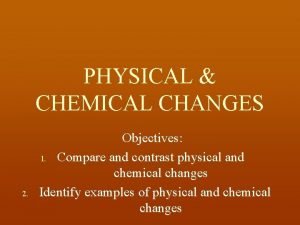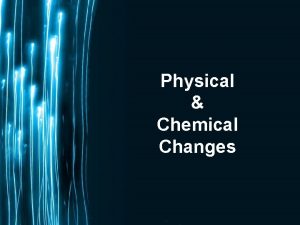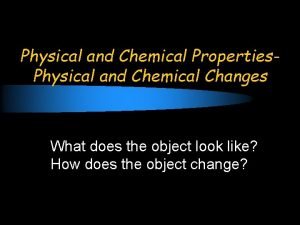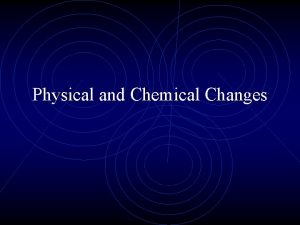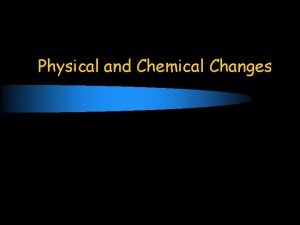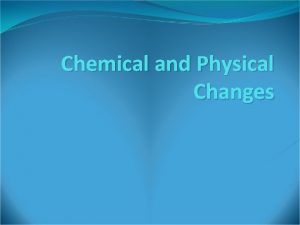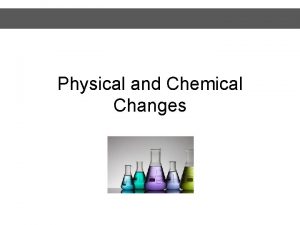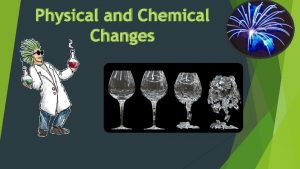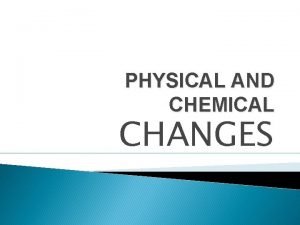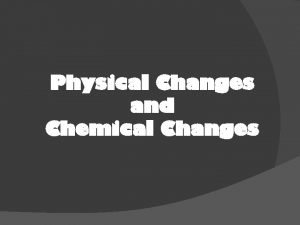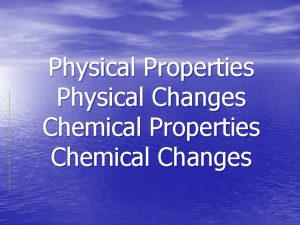Chemical and Physical Changes Chemical Changes Chemical changes










- Slides: 10

Chemical and Physical Changes

Chemical Changes Chemical changes take place on the molecular level. A chemical change produces a new substance. Examples of chemical changes include combustion (burning), cooking an egg, rusting of an iron pan, and mixing hydrochloric acid and sodium hydroxide to make salt and water. Chemical changes occur when a substance combines with another to form a new substance, called synthesis or, alternatively, decomposes into two or more different substances. These processes are called chemical reactions and, in general, are not reversible except by further chemical reactions. Some reactions produce heat and are called exothermic reactions and others may require heat to enable the reaction to occur, which are called endothermic reactions. Understanding chemical changes is a major part of the science of chemistry.

When chemical reactions occur, the atoms are rearranged and the reaction is accompanied by an energy change as new products are generated. An example of a chemical change is the reaction between sodium and water to produce sodium hydroxide and hydrogen. So much energy is released that the hydrogen gas released spontaneously burns in the air. This is an example of a chemical change because the end products are chemically different from the substances before the reaction. Chemists categorize chemical changes into three main classes: inorganic chemical changes, organic chemical changes and biochemical changes.

Physical Changes Physical changes are concerned with energy and states of matter. A physical change does not produce a new substance. Changes in state or phase (melting, freezing, vaporization, condensation, sublimation) are physical changes. Examples of physical changes include crushing a can, melting an ice cube, and breaking a bottle. Physical changes are changes affecting the form of a chemical substance, but do not change the chemical composition of that substance. Physical changes are used to separate mixtures into their component compounds, but can not usually be used to separate compounds into chemical elements or simpler compounds.

Physical changes occur when objects or substances undergo a change that does not change their chemical composition. This contrasts with the concept of chemical change in which the composition of a substance changes or one or more substances combine or break up to form new substances. In general a physical change is reversible using physical means. For example salt dissolved in water can be recovered by allowing the water to evaporate. A physical change involves a change in physical properties. Examples of physical properties include melting, transition to a gas, change of strength, change of durability, changes to crystal form, textural change, shape, size, color, volume and density. An example of a physical change is the process of tempering steel to form a knife blade. A steel blank is repeatedly heated and hammered which changes the hardness of the steel, its flexibility and its ability to maintain a sharp edge.

Many physical changes also involve the rearrangement of atoms most noticeably in the formation of crystals. Many chemical changes are irreversible, and many physical changes are reversible, but reversibility is not a certain criterion for classification. Although chemical changes may be recognized by an indication such as odor, color change, or production of a gas, every one of these indicators can result from physical change. Examples of physical changes: Heating and Cooling Magnetism Mixtures Solutions Alloys

How to Tell Chemical & Physical Changes Apart A chemical change makes a substance that wasn't there before. There may be clues that a chemical reaction took place, such as light, heat, color change, gas production, odor, or sound. The starting and ending materials of a physical change are the same, even though they may look different.

Physical Properties Physical Property A physical property is one that is displayed without any change in composition. (Intensive or Extensive) Intensive: A physical property that will be the same regardless of the amount of matter. density: m/v color: The pigment or shade conductivity: electricity to flow through the substance malleability: if a substance can be flattened luster: how shiny the substance looks Extensive: A physical property that will change if the amount of matter changes. mass: how much matter in the sample volume: How much space the sample takes up length: How long the sample is

Physical Change in which the matter's physical appearance is altered, but composition remains unchanged. (Change in state of matter) Three main states of matter are: Solid, Liquid, Gas Solid is distinguished by a fixed structure. Its shape and volume do not change. In a solid, atoms are tightly packed together in a fixed arrangement. Liquid is distinguished by its malleable shape (is able to form into the shape of its container), but constant volume. In a liquid, atoms are close together but not in a fixed arrangement. Gas is made up of atoms that are separate. However, unlike solid & liquid, a gas has no fixed shape and volume. Example: When liquid water (H 2 O) freezes into a solid state (ice) -- It appears different/changed; However, the composition is still: 11. 19% hydrogen and 88. 81% oxygen by mass.

Chemical Properties Chemical Property: Any characteristic that gives a sample of matter the ability/inability to undergo a change that alters its composition. Examples: Alkali metals react with water; Paper's ability to burn. Chemical Change: Change in which one or more kinds of matter are transformed to new kinds of matter with altered compositions. (Or Chemical Reaction): Examples: Magnesium + Oxygen → Magnesium Oxide or 2 Mg + O 2 → 2 Mg. O Iron + Oxygen → Iron Oxide/ Rust or 2 Fe + 3 O 2 → Fe 2 O 3
 What is a physical change
What is a physical change Compare and contrast chemical and physical changes
Compare and contrast chemical and physical changes Physical change
Physical change Physical and chemical changes
Physical and chemical changes Is sawing wood a chemical change
Is sawing wood a chemical change Generation genius physical and chemical changes
Generation genius physical and chemical changes Physical and chemical changes
Physical and chemical changes Physical change
Physical change Differences between physical and chemical changes
Differences between physical and chemical changes Lesson 3 physical and chemical changes answers
Lesson 3 physical and chemical changes answers Whats the difference between chemical and physical change
Whats the difference between chemical and physical change

